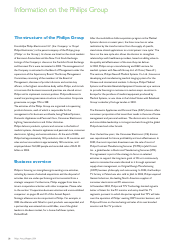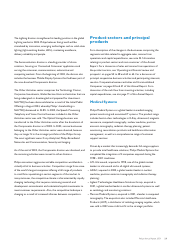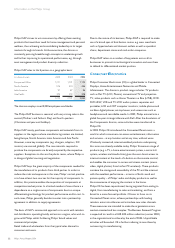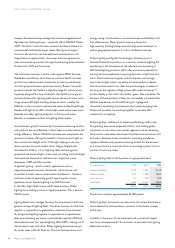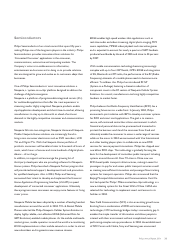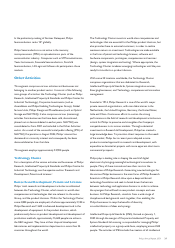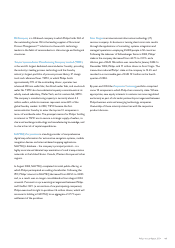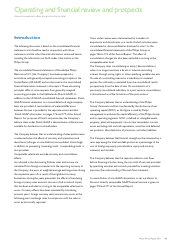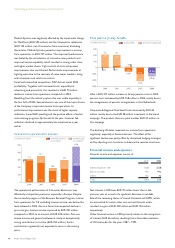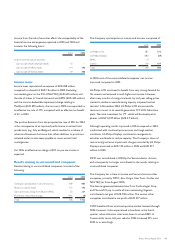Philips 2004 Annual Report Download - page 38
Download and view the complete annual report
Please find page 38 of the 2004 Philips annual report below. You can navigate through the pages in the report by either clicking on the pages listed below, or by using the keyword search tool below to find specific information within the annual report.In the preliminary ranking of Gartner Dataquest, Philips
Semiconductors ranks 10th globally.
Philips Semiconductors is not active in the memory,
microprocessors (MPU) or optoelectronics parts of the
semiconductor industry. Companies such as STMicroelectronics,
Texas Instruments, Freescale Semiconductors, Fairchild
Semiconductors, LSI Logic and Infineon do participate in those
markets.
Other Activities
This segment comprises various activities and businesses not
belonging to another product sector. It consists of the following
main groups of activities: the Technology Cluster (such as Philips
Research, Intellectual Property & Standards and Philips Center for
Industrial Technology), Corporate Investments (such as
Assembléon and Philips Enabling Technologies Group), Global
Service Units, Philips Design and Miscellaneous (such as Optical
Storage and NAVTEQ). It also comprises various (remaining)
activities from businesses that have been sold, discontinued,
phased out or deconsolidated in earlier years. NAVTEQ was
consolidated as from 2001 and included in the Other Activities
sector. As a result of the successful initial public offering (IPO) of
NAVTEQ Corporation in August 2004, Philips’ interest has
decreased to a minority interest and consequently has been
deconsolidated as from that date.
This segment employs approximately 23,900 people.
Technology Cluster
For a description of the various activities and businesses of Philips
Research, Intellectual Property & Standards and Philips Centre for
Industrial Technology, see the separate section ‘Research and
Development, Patents and Licenses’.
Research and Development, Patents and Licenses
Philips’ total research and development activities are allocated
between the Technology Cluster, which invests in world-class
competencies and technologies that are relevant to the entire
Group, and the product divisions. Within the Technology Cluster,
some 4,800 people are employed, of whom approximately 2,100 in
Philips Research and 1,600 in advanced development and in the
development of equipment. In the product divisions, which
predominantly focus on product development and development of
production methods, approximately 15,600 people are active in
the R&D segment. They have at their disposal development
laboratories and implementation departments in more than 25
countries throughout the world.
The Technology Cluster invests in world-class competencies and
technologies that are essential for the Philips product divisions, but
also provides these to external customers, in order to realize
maximum return on investment. Technologies are made available
in the form of patent and technology licenses, software and
hardware components, prototypes, competencies and services
(design, system integration and testing). Where appropriate, the
Technology Cluster incubates emerging technologies until they are
ready for transfer to a product division.
With some 20 locations worldwide, the Technology Cluster
comprises organizations that are dedicated to: Research,
Intellectual Property & Standards, System integration services,
Emerging businesses, and Technology, competence and innovation
management.
Founded in 1914, Philips Research is one of the world’s major
private research organizations, with main laboratories in the
Netherlands, the United Kingdom, Germany, the United States,
India and China. Continuous efforts to sustain the strong
performance in the field of research and development activities are
critical for Philips to preserve and strengthen the Company’s
competitiveness in its various markets. Through substantial
investments in Research & Development, Philips has created a
large knowledge base. To provide a direct response to the needs
of the market, Philips has in recent years adopted a more
product-oriented approach to research and development, with
expenditures directed at projects with more apparent short-term
commercial prospects.
Philips plays a leading role in shaping the world of digital
electronics by bringing meaningful technological innovations to
people. Many of these innovations have their roots in the
laboratories of Philips Research. Generating new technologies for
the various Philips businesses is the main focus of Philips Research.
Scientists at Philips Research draw upon a deep and broad
technology foundation and seek to break down the barriers
between technology and application domains in order to achieve
the synergies that will lead to new product concepts and new
business. At Philips Research, scientists from a wide range of
disciplines and backgrounds work together, thus enabling the
Philips businesses to reap the benefits of diversity,
cross-fertilization of ideas and synergy.
Intellectual Property & Standards (IP&S), formed on January 1,
2002 through the merger of Corporate Intellectual Property and
System Standards & Licensing, is responsible for managing Philips’
intellectual property on a group-wide basis, employing around 500
people. The activities of IP&S include the creation of all intellectual
37Philips Annual Report 2004



